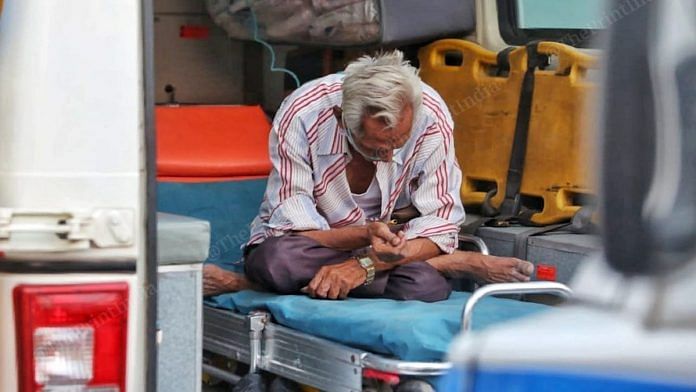Ahmedabad: Increased ‘ground glass opacity’, lung damage and the sudden onset of pneumonitis (lung inflammation) — these are some of the problems that Covid patients in Ahmedabad are facing right now, according to doctors.
Reports from across India have suggested that the surge in Covid cases is due to a ‘double mutant SARS-CoV-2’, but in Ahmedabad, not only does it seem more virulent, but is showing unpredictable behaviour, leaving doctors concerned.
The area under Ahmedabad Municipal Corporation reported about 2,500 new Covid cases Wednesday, with 24 deaths, continuing a 15-day spike. And these additional complications are forcing residents towards oxygen cylinders and ventilator beds.
However, a senior health official in the Ahmedabad Municipal Corporation denied any such trend. He told ThePrint on the condition of anonymity: “Compared to the number of cases, there are very few complications. We have a lot of ‘mild’ patients — about 60-70% of the cases are mild and can do with home isolation. The problem that hospitals were facing was the shortage of oxygen supply and remdisivir.”
The official added: “The virus is not virulent, and only senior (citizen) patients with comorbidities are facing complications. And if a person is fully vaccinated, then the chances of complications are even smaller.”
Also read: Gasping patients wait in ambulances, Ahmedabad’s largest Covid facility has no bed for them
Aggressive strain
Dr Rajnish Patel, the additional medical superintendent of the Ahmedabad Civil Hospital, who first informed ThePrint of the trends in the city, said: “With the virulence of the new strain and the grim situation at hand, more and more oxygen and ventilatory beds are being occupied. Keeping with last year’s trend, 60-70 per cent of the patients coming in are above 40 years of age.”
Patel added: “The mutant strain of the virus is affecting the patients in such an aggressive manner that they need oxygen beds. The cycle is such that patients test negative after 13-14 days, so they stop spreading the disease. But complications in the lungs exist for three months. Though the patient is RT-PCR negative after two weeks, their lung capacity is deteriorated or completely destroyed to such a level that they need oxygen support and supervision for three months.”
Dr Sunil Mehta, a senior private physician in the city, concurred. “In the latest Covid surge, the lungs of the patients are getting severely affected. While the rest of the body is fine, suddenly the patient gets breathless and we find out he has hypoxia. We are also seeing increasing ground glass opacity much quicker in patients now than before. We are also witnessing a sudden onset of pneumonitis amongst Covid patients this time around.”
Ground glass opacity (GGO) refers to the hazy grey areas that can show up in CT scans or X-rays of the lungs. These grey areas indicate increased density inside the lungs.
Dr Manoj Vithlani, a consultant physician also noted that Covid patients he attended to showed a severe adverse response on the eighth or 10th day of hospitalisation. “This is a worrying trend; the patient’s condition remains stable for the initial period and then suddenly we see them collapsing on the eighth or 10th day,” he said.
Genomic differences
Talking about the genomic differences in the mutant strain, Vithlani said: “When the city had a surge post Diwali last year, the ‘S’ gene was present in patients. This time the ‘S’ gene is absent, which shows that it is a mutant. But in some cases, we have seen that an additional ‘E’ gene is also absent. We have also noted that the ‘N’ and ‘ORF’ genes are usually present in patients.”
There are two target genes that instruments detect, ‘E’ and ‘ORF1A’. ‘ORF1A’ is unique to SARS-CoV-2 and, therefore, when it is the only gene detected, it confirms positivity. However, the ‘E’ gene is shared with the original SARS virus and other bat coronaviruses.
Dr Tarun Patel, who is part of Gujarat’s Covid task force, affirmed the trend and said. “Compared to last year this year we are witnessing that more patients require oxygen support. Their lung condition is deteriorating very fast, in the CT scans, we are seeing the severity going up to 10-12 points, from 5-6 in previous waves. This could be an indication of a different strain of the virus. Patients are getting breathlessness even walking the distance from their bed to the bathroom,” he said.
“The virus is mutating fast because it is now affecting more people. Even if one member of the family is infected, everyone in the family ends up falling prey. We don’t know much about this strain right now,” Tarun Patel added.
About the age group of patients, he said: “Most of the people getting affected are young people with no comorbidities. Even children, who were previously considered asymptomatic carriers, are now getting infected and showing severe symptoms.”
(Edited by Shreyas Sharma)
Also read: Outside Ahmedabad’s largest Covid hospital, long queue of ambulances & endless wait for bed



